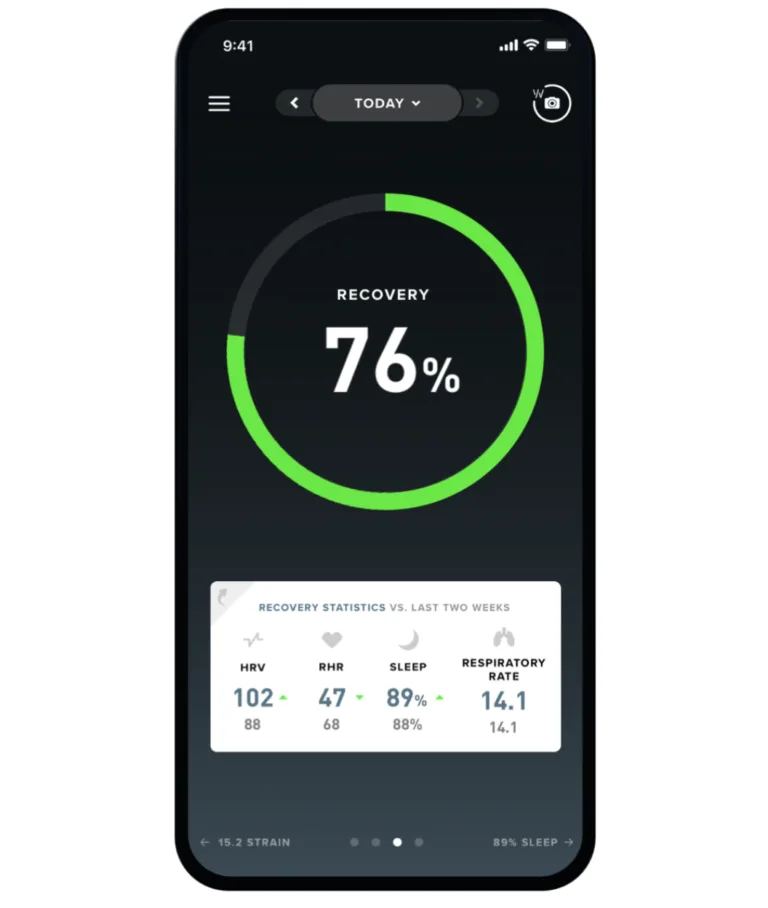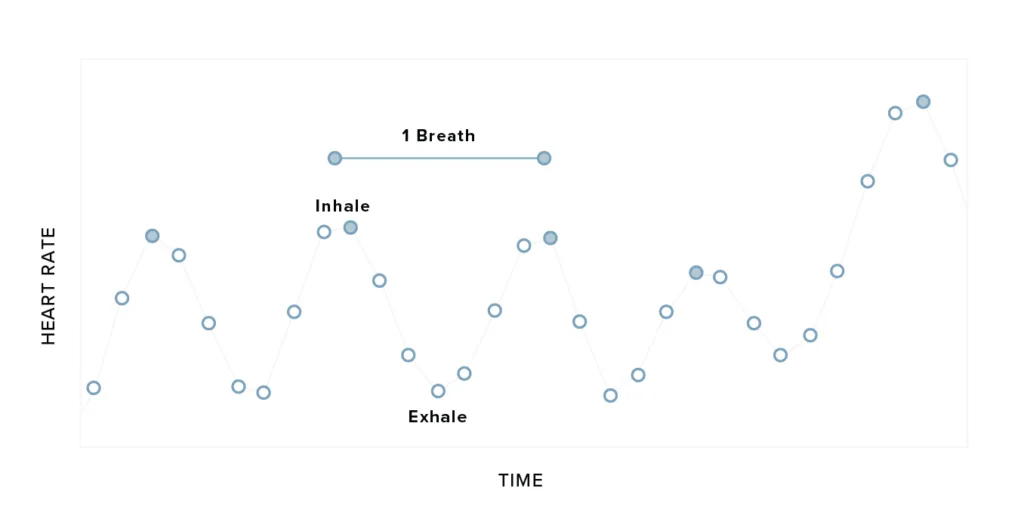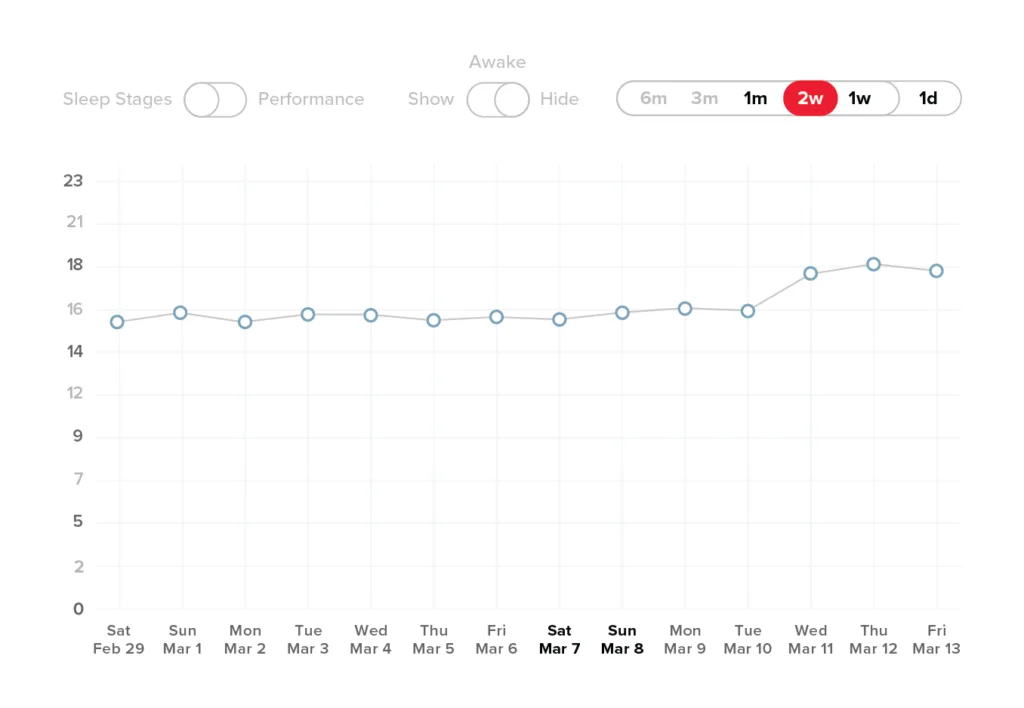Topics
- Article
- COVID-19
- Respiratory Rate
The Importance of Respiratory Rate Tracking During The COVID-19 Pandemic
Learn more about how we measure respiratory rate and why it’s so important.
How Respiratory Rate May Help Monitor Coronavirus
In response to the COVID-19 pandemic, WHOOP released a fast-tracked update to our mobile apps which makes it easier for members to monitor and interpret their respiratory rates. Why? It might be the most significant metric to track if you are concerned about COVID-19. Read on to learn more about how we measure respiratory rate and why it’s so important.

WHOOP tracks respiratory Rate while you sleep, significant changes in it may be meaningful.
What is Respiratory Rate?
Respiratory rate, reported in respirations (breaths) per minute (rpm), typically ranges from 12 to 20 rpm at rest. Each respiration has two phases: Inhalation and exhalation. During inhalation oxygen is brought into the lungs from where it is transported throughout the body via the bloodstream, and during exhalation carbon dioxide is eliminated.
How Does WHOOP Measure Respiratory Rate?
Last year, WHOOP upgraded our sleep analytics platform to include resting respiratory rate in our web app. Earlier this year, we became the first wrist-worn wearable device to validate the accuracy of our respiratory rate measurement during sleep. In this third-party study, published in the Journal of Clinical Sleep Medicine, WHOOP respiratory rate was shown to be within one breath per minute of gold-standard truth. WHOOP reports the median respiratory rate during sleep. We calculate respiratory rate from heart rate data by taking advantage of a phenomenon known as respiratory sinus arrhythmia. Described simply, when we breathe in, our heart rate increases and when we breathe out our heart rate decreases, allowing us to preferentially pass blood by the lungs while they are full of oxygen. Because our autonomic nervous systems increase heart rate during inhalation and decrease heart rate during exhalation, we can see the respiratory rate in continuous heart rate data by looking for this cyclical increase/decrease pattern.

A chart displaying respiratory rate over heart rate.
Take for example 25 seconds of my heart rate data below--you can see that the heart rate cycles up and down about every 5 seconds, corresponding to a respiratory rate of about 12 breaths per minute.
Why Is Respiratory Rate Worth Tracking?
Even before we started reporting respiratory rate last year, WHOOP had been tracking it throughout sleep for years. Our sleep staging algorithms use minute-by-minute changes in respiratory rate because respiratory patterns change with sleep stages. Initially, WHOOP didn’t display respiratory rate because it generally follows a similar trend as heart rate variability (HRV) and resting heart rate (RHR), so it wasn’t immediately obvious how our members would action this additional information. However, as we gathered more data and increased the sophistication of our algorithms to improve accuracy, we discovered something interesting: While respiratory rate is generally an indicator of cardiovascular fitness and load, and therefore increases when resting heart rate increases and decreases when resting heart rate decreases, it is also a remarkably stable metric. From night to night, users should not expect to see much change in their median respiratory rate statistic. When it does change, however, that change tends to be meaningful.
Increased Respiratory Rate Can Be a Sign of Trouble
For this reason, respiratory rate is a useful metric because it makes it easy to spot sleeps in which “something was up.” On the other hand, RHR and HRV can meaninglessly change a few beats per minute or a few milliseconds from day to day. In statistics, this property is known as the “signal to noise ratio,” and it helps determine how much change you need to confidently conclude that a change is meaningful and not random variation. Median respiratory rate has a remarkably high signal to noise ratio, making it very easy to interpret and trust.

WHOOP tracks the increase in respiratory rate in a person diagnosed with coronavirus.
Take for example, the resting respiratory rate data of one WHOOP member, shown here with the member’s permission, as they came down with the coronavirus. This WHOOP member was exposed to COVID-19 on March 7th and began experiencing symptoms on March 11th. During the 10 days before they became sick, notice how little respiratory rate changed from night to night--it varied only from a low of 15.4 rpm to a high of 16.1 rpm. Compare this to the 11th through 13th where respiratory rate shot up to over 18.1 rpm. While in absolute numbers, this increase might not seem huge, when ordinarily stable baselines suddenly jump up over 17% that suggests something significant is going on. To view your long-term respiratory rate trends, log in to your account via our web app at app.whoop.com, then select a date range and go to “Sleep Performance” in the top right of the screen. You'll see respiratory rate in your stats on the left, and can click to expand. It’s worth noting that it doesn’t have to take a deadly pandemic to increase respiratory rate. In the past few months (before we started practicing social distancing) I took a handful of overnight flights, and some of my personal highest respiratory rates happened when I was sleeping on an airplane. We’ve also observed that traveling from low to high altitude can cause an elevated respiratory rate that resolves upon return to the lower altitude; this phenomenon makes sense given the lower oxygen content of air at higher elevations. When respiratory rate is elevated due to sleeping on a plane with stale, dry air or at altitude with lower oxygen content, that’s a response to the environment and not necessarily cause for concern. However, what we are seeing in WHOOP members self-reporting COVID-19 infections is a physiological response to the disease and therefore potentially worthy of attention.
COVID-19 and Respiratory Rate
In order to understand why the coronavirus might cause elevated respiratory rate, it’s important to understand the pathology of the infection. COVID-19, the disease caused by the SARS-CoV-2 virus, is a new disease, but in most moderate to severe cases it presents as a lower-respiratory tract infection, similar to bronchitis and some strains of the flu. Lower respiratory tract infections differ from the more common upper respiratory tract infections in the part of the respiratory tract that they impact. Upper respiratory tract infections, which include most strains of the common cold, tonsillitis, and sinus infections, are primarily characterized by symptoms above the collar--runny nose, headache, sore throats. Lower respiratory tract infections take root below the larynx and therefore are more commonly associated with coughing, fatigue, and shortness of breath. In a viral lower respiratory tract infection such as COVID-19, the virus enters the body through the nose, mouth, or eyes and travels down the respiratory tract in search of a host cell. Viruses cannot reproduce on their own and therefore need a host to “hijack,” overriding the cell’s normal function with a new command: Reproduce the virus. Once the cell is full of new virus, the cell will burst and the newly formed virus will then set out in search of even more host cells. During the early stages of infection, often called “incubation,” there are enough healthy (not yet hijacked and destroyed) cells to compensate for their fallen neighbors, but as the number of virus organisms in the body grows, the rate at which damage is being done also grows, the healthy cells can eventually no longer cover for the burst ones, and organ function is impacted. This impact is experienced as “symptoms.” Symptoms vary depending on the function of the cells that were damaged; in COVID-19, the virus infects the alveoli. Alveoli are the blood/lungs interface at which oxygen passes from the lungs to the blood and carbon dioxide passes from the blood to the lungs. Without functioning alveoli, each respiration does not remove as much carbon dioxide from the blood or provide as much oxygen to the blood as it used to. To make up for the loss of efficiency per breath, the body is forced to undergo more respirations to provide the same blood oxygen supply.
Normal Respiratory Rate Fluctuation & Why We Measure it During Sleep
In a healthy individual, it is normal for daily respiratory rate to fluctuate based on what we are doing and therefore what our acute need is for oxygen. Exercising is a great example--we breathe harder and faster when running than when standing still because while running our need for energy, and therefore oxygen, is higher. Because variation within a day is more dramatically varied by activity level than it is by acute changes in efficiency, measuring respiratory rate throughout the day provides less insight into efficiency than does measuring respiratory rate during sleep. Since our need for oxygen is roughly constant from night to night (assuming the oxygen quality of the air is the same), you would expect respiratory rate to be the same. Therefore, when - as in the case study provided above - we see a sudden increase in sleeping respiratory rate, it is reasonable to consider changes to respiratory efficiency rather than energy need.
High Respiratory Rate is Less Common with Other Illnesses
If you are in the US like I am, in addition to the COVID-19 pandemic it’s also still flu season, and for some of us, it’s almost allergy season. This means that there could be non-COVID-19 explanations for our coughs, fatigue or general less-than optimal feelings of wellbeing. Since most strains of the flu and most allergies primarily impact the tissues of the upper respiratory tract, elevated respiratory rate is a less common symptom; this means that if you are feeling crummy, knowing if your respiratory rate is elevated above your personal baseline may help provide useful information to help get an accurate diagnosis as quickly as possible. WHOOP is not a medical device, our products and services are not intended to diagnose COVID-19, the flu or any other disease, and should not be used as a substitute for professional medical advice, diagnosis or treatment. Learn more about how COVID-19 is impacting WHOOP members around the world and how prioritizing sleep might help keep you healthy during the pandemic. https://www.whoop.com/thelocker/covid-health-monitoring-tips-resources/